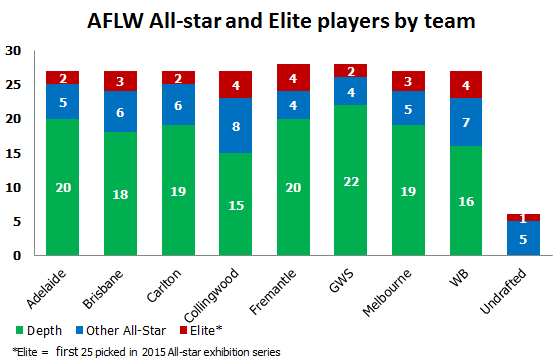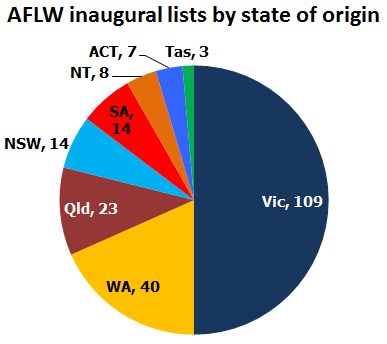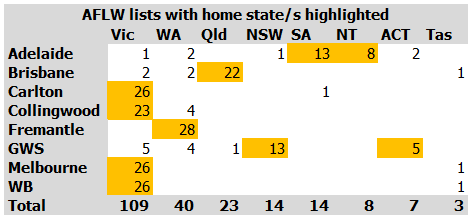Earlier this week, we took a look at the composition of the AFLW inaugural lists by state and using All-Star status as a measure of the distribution of elite talent. Here, we’re going to update our earlier power ranking to factor in actual team selections.
This is the power ranking as we think it stands. We can’t yet speak to factors such as team balance, tactics, or statistics, so the two main factors we have available for consideration are:
- the distribution of elite talent; and
- estimated strength of the depth players, measured by past performances of each state team in representative matches.
1 – Collingwood
Collingwood have assembled the most top talent
Collingwood have the most former All-Star players, a full 12 of 75, nearly one-fifth of those playing in the 2017 AFLW. With 16-a-side and 22 named for each match, this is a strong but not decisive advantage.

The Pies recruited Emma King from WA as a marquee and also have Moana Hope, Meg Hutchins and Stephanie Chiocci from the elite upper echelons of the All-Star talent pool. Nicola Stevens was a 2016-only All-Star player, but was called the best defender in the AFLW draft and may also be a very strong talent for the Pies. On a sheer count of proven talent, Collingwood must be considered a premiership favourite.
Of all the teams, Collingwood may have the most potent forward line on paper, with five-time VFLW leading goalkicker Hope joined by St Kilda Sharks teammate Jasmine Garner, 2011 VFLW leading goalkicker Sarah D’Arcy and Australian Cricketer Jess Cameron. The Pies ruck division also has enviable depth, with WA standout King joined by the up-and-coming East Freo ruck Ruby Schleicher and former two-time VFLW best and fairest Lou Watton. Watton should be the most productive of any of the free agents selected if she can get up to her previous form, and is an absolute steal as a free agent.
More than any other club, the Pies are gambling on the strength of their spine over that of their midfield – they also have the current VFLW Team of the Year full back in their team too. The only slight question comes around midfield depth, but the delivery of the ruck and strength of their utilities (such as current VFLW B&F Emma Grant) should help them compete.
Collingwood’s recruitment strategy also stands out from the other Victorian teams. They are the only Melbourne side to recruit multiple Western Australians – and good ones to boot. Three of their four WA players were recruited through the draft, meaning that the Pies had to convince those players to enter the Victorian pool instead of the WA one, suggesting direct contact before the draft.
You could flip Fremantle ahead of Collingwood if you want, but for our money Collingwood sit as the standout at this stage.
2 – Fremantle
Fremantle have been brought back to the pack but should still be very strong
Fremantle only have four of the “elite” 25 players, about average in the league. This is in spite of Western Australians constituting a full third (i.e. nine) of the “elite 25” players.
We predicted in June that other clubs would raid Western Australia for marquee signings and this has eventuated. This is very good for the competitive balance of the league – the transfer of Chelsea Randall and Kellie Gibson to Adelaide, Emma Swanson and Renee Forth to GWS, and Emma King to Collingwood, all as marquees, has probably blunted the Dockers enough that they’re not clearly and easily the best team in the competition as a full WA side would have been.
Fremantle have 28 of the 40 Western Australians in the league, but have lost five of the best players in the game. Only 10 of the 27 listed players on the Dockers list played for Western Australia in the June exhibition match against the Bulldogs.
Of all the areas around the ground, it appears that the Dockers ruck strength took the biggest hit. Emma King decamped to Collingwood, Sabrina Frederick-Traub (a KPF who goes in the ruck) headed up north to Brisbane and Ruby Schleicher also headed to the Pies.
The single biggest unknown for the AFLW remains how strong each club’s depth players are. That depth will be a function of the depth of the talent in that state and it’s here we think Fremantle gain an edge. We know that Western Australia’s state team has a track record of matching half-strength Victorian teams (for example earlier this year versus a Western Bulldogs aligned squad), and we know a full fifth of the competition talent pool is Western Australian, and that Fremantle are happy to pick their whole team from their home pool. However, the sheer loss of elite talent is hard to ignore, and Fremantle have had to dive into the fringes of talent in some positions due to interstate raids.
In summary, we think it’s reasonable to believe that despite the important levelling effect of marquee player poaching, Fremantle’s non-elite depth will be better than the 1/4 of Victoria available in the draft to each Victorian club. So we think they will still contend for the first title.
3 – Western Bulldogs
The Bulldogs look pretty stacked with elite talent
The Bulldogs also have four of the elite 25 we’ve identified and 11 of 75 All-Star players. These playersinclude Katie Brennan and Aasta O’Connor (both entrenched former Queenslanders) as well as Emma Kearney and Ellie Blackburn. Three of these were among the six the Bulldogs retained and pre-listed in 2015, with the Dogs clearly benefiting from the loyalty cultivated through that longer club connection.
O’Connor is one of the game’s premier rucks, but her standing slid this year due to a knee injury she’s yet to return from. Having Brennan up forward and O’Connor in the ruck (if fit) give the Bulldogs a powerful spine and the spread of proven talent should put them in the frame to push for a grand final.
However it is their midfield that shapes as being potentially the most potent in the competition, with the Dogs lining up three of the five current VFLW Team of the Year starting midfielders in Blackburn, Lambert and Kearney. They also have two of the top VFLW defenders in Ebb and Scott.
One factor which might help the Dogs gain an edge is their prior experience running a women’s team, however they have lost their coach along the way to Brisbane.
4 – Brisbane Lions
Brisbane are effectively the Queensland state team
The Lions have managed to recruit nearly everyone from Queensland, making them a nearly exact match for the strong Queensland state side of recent years, but leavened with a sprinkle of top talent from elsewhere. Queensland is clearly the third strongest state in womens footy and so a team made up of nearly all of its talent should be a strong competitor.

There are, however, three significant missing QLD players. Katie Brennan and Aasta O’Connor are ex-QLDers but counted in our figures as Victorian due to being drafted from the Darebin Falcons after spending the last few years there. Brennan was a Bulldogs’ marquee signing and O’Connor was drafted from the pool, nominating for Victoria. It was unlikely that either would go back to Brisbane, but if the Lions had managed to lure them, they’d possibly be topping this power ranking.
The other big absence for the Lions is Jordan Zanchetta with an ACL injury, leaving her undrafted.
In terms of interstate recruits, Brisbane signed Sabrina Frederick-Traub from WA as a marquee. We didn’t call her “elite” in our figures because she wasn’t drafted to the first 2015 All-Star game which gave us the only definitive ranking of talent as defined by the keenest observers. However, she’s currently 19 and was drafted to the second game in 2015 through a mini-draft at a very young age, so she is clearly an emerging star. Together with Tayla Harris, Frederick-Traub should give Brisbane a powerful forward line.
Kaitlyn Ashmore, from Victoria, was already working at the Lions and signed as a priority pick on that basis. Jessica Wuetschner also deserves a mention as likely the most travelled player in the league – originally Tasmanian, she was drafted to Brisbane from Claremont in WA, in what must have been a pre-arranged state nomination.
Despite the elite QLD absences, we can therefore stand by our June assessment that Brisbane should be fairly strong. Excluding Frederick-Traub, the Lions have secured 9 of the 75 All-Star players (ranked third for this) and three elite players in Tayla Harris, Emma Zielke and Kaitlyn Ashmore.
The question is again depth – whether Brisbane’s local talent is equal to one quarter of Victoria’s depth. Past records show Queensland representative teams being a step below WA or half-strength Victorian teams, but there’s no reason at this stage not to assume that their depth won’t be competitive with the quarter-strength Victorian depth available to each Victorian side through the draft.
The Lions also have advantages all of their own. Their core should already be familiar to each other and to their experienced coach in Craig Starcevich, who has worked with most of the players at Queensland or the Bulldogs All-Star team. They’ll have the summer heat of Brisbane on their side. We expect them to contend strongly for finals.
5- Melbourne
Melbourne look to be a step behind the Pies and Dogs
Melbourne’s eight All-Star players include three elite players, meaning they show notionally as touch stronger than Carlton. Melbourne have kept Daisy Pearce and Melissa Hickey from among their six pre-listed 2015 players, losing the others interstate. Their other elite player is Elise O’Dea.
Pearce is probably the best player in the league, and the Demons have 6 of the 14 Darebin Falcons including Pearce, Hickey and O’Dea, so their core of elite players will have some familiar teammates around them. We expect with such a short pre-season that pre-existing chemistry will be a factor, and the Dees have also banked on this.
The Demons have a relatively strong backline, with VFLW Team of the Year members Hickey and Paxman lining up in defence. The main difference between the two Victorian teams named above and the Demons is that they are lacking just a little in established top-end talent.
Overall, in terms of proven top-level talent, the Dees have not assembled the same quality as the Magpies or Bulldogs. The Demons’ biggest advantage is likely to be a head-start in off-field factors, having already run a women’s team along with the Bulldogs in the All-Star series over recent years.
6 – Carlton
Carlton are relatively unheralded
Carlton’s two players from the elite 25 are Darcy Vescio (originally pre-listed by the Bulldogs in 2015, making her one of the best 12 players in the country) and Katie Loynes. Loynes is a question mark – she was drafted at pick 110 likely due to being in recovery from a serious knee injury.
The Blues have recruited relatively strongly from the VFLW, with six players from the 2016 team of the year. But most of these players come from the flanks, and their tall strength will really be tested. Time will tell, but their drafting strategy will need to have been top notch to overcome the more fancied lists like Collingwood or the Bulldogs.
HPN has rated the Blues behind Melbourne. On paper it seems like the Demons might have a very good to great defensive unit, whereas Carlton doesn’t appear to be particularly strong in any one part of the ground. Additionally Carlton appears to have the most diverse set of recruited players of the Victorian sides, with each predicted line being filled with players from multiple teams, presenting a potential cohesion issue.
7 – GWS
GWS should struggle with depth
GWS and Adelaide are the two sides who have drawn most heavily from beyond their own city. Both also have significant secondary bases in the ACT and Northern Territory.

The Sydney and Canberra player pools are a bit less dominated by a single club than the NT and SA. This means that a big challenge for GWS will be in forming a team from individual stars used to dominating their local teams and games. The GWS list pulls from far and wide, recruiting players from 18 different clubs in half a dozen competitions. No other club will have as few players as familiar with each other via week-to-week club games as GWS. The most players GWS have from a single club is four from the UNSW-Eastern Suburbs Bulldogs.
The other issue is that the depth of the local NSW/ACT players is relatively unknown. Will they step up their games when training with the best regularly? Who knows at this point.
Where we think GWS has an edge over Adelaide below is their larger group of representative-level recruits from the three “power states” of Victoria, WA and Queensland. The Giants have 10 from these states. Compared with the Crows, the Giants may have as few as six local players on the ground at key points, compared with a minimum of 13 for the Crows.
The Giants sourced several pre-draft priority picks from Victoria. Those are Jessica Dal Pos and Phoebe McWilliams as recent All-Stars, plus Louise Stephenson who represented the Bulldogs at age 18 in the first exhibition match back in 2013.
Of the WA contingent, Alex Williams played for Western Australia this year. Ashleigh Guest, drafted from Victoria, played in the half-Victorian Melbourne exhibition team. Aimee Schmidt played for the Eagles in the Western Derby exhibition game, placing her near WA representative level.
Clare Lawton, based with the Army in Townsville, and Alex Saundry from Melbourne Uni are the only power-state players who seem to have been outside representative level this year.
The season-ending injury to Forth will hurt the Giants but they do seem to have at least a core group of established state representative players. Collectively, alongside the five fit recent All-Star players is a group of five who we call “depth” level, but who nonetheless have been representative calibre players in WA or Victoria.
8 – Adelaide
Adelaide should also struggle
South Australia is not a strong women’s football state at the present time. It has had barely any players selected to play All-Star games and as a representative side is somewhere around the strength of NSW.
The SA/NT talent base is probably at least on par with NSW/ACT. South Australia traditionally struggled in past representative fixtures, for example losing a 2013 Championships Division 2 grand final to the ACT. However, the recent (2016) narrow win by SA/NT over NSW/ACT suggests the talent base has caught up in terms of the depth available to each club.
Both “elite” Crows players are from WA, the Chelsea Randall and Kellie Gibson. Randall in particular comes highly rated, being among the dozen players prelisted by the two teams that year before the draft.
The Crows’ other five All-Star players break down as three from the Northern Territory and two from South Australia, illustrating the critical importance for the viability of the Crows in securing the NT as a secondary market and talent base.
Adelaide’s only other “power state” player is Sarah Perkins, who kicked 52 goals and was named in the VFLW team of the year this year, and who played for the half-Victorian Melbourne exhibition team. This is a notable contrast to the Giants’ larger group of such players.
The bulk of Adelaide’s list is players from Morphettville Park (8) and Waratah (5), the strongest teams in Adelaide and Darwin. Thirteen of fourteen South Australians in the inaugural AFLW list are at the Crows (the exception is a non-football rookie at Carlton), as are all eight from the Northern Territory. This group’s ability to transition from dominating at home to matching it with players from stronger competitions in WA, QLD and Victoria will be crucial to their prospects.
Danielle Goding is a very notable absence – probably the most significant absence in the AFLW. She was pick 2 (therefore rated 14th best) in the 2015 All-Star draft but doesn’t seem to have played football above club level since this rep game in March. She still played in the SAWFL grand final in September, but only played 8 club games this year (and one reserves game).
Given the apparent weakness of the local recruiting pools, it’s hard to see the depth on the Crows’ list being able to match the depth at the Victorian clubs, at Fremantle, or at Brisbane. Compared to GWS, Adelaide’s cream of interstate talent looks slightly better, but there’s less of it compared to the larger foreign legion at the Giants. If the Crows are competitive, it will be on the back of new and unanticipated improvement in their local player base.
